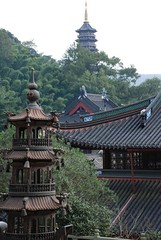Gyokuko and I are in a van heading east, away from LAX. We notice how clean everything is. The air, the streets, everything. When I comment on this, the driver is surprised. I tell him that compared to anywhere we were in China Shanghai
I am being driving to an urgent care clinic by an airport first aid technician. It was quite an adventure to be met at the plane by a man with a wheelchair, then taken directly through immigration – no waiting – and to the first aid clinic. I got through the entire trip with no difficulties, only to get violently sick on the flight from Seoul Portland
Our last couple of days in China Shanghai with a trip to the magnificent museum, a visit to a demonstration silk production facility, then the Jade Buddha Temple
The museum had a display of Tang Dynasty Chinese Buddhist art on loan from Japan
While most of the group toured the silk production demonstration, Andy, Shisei and I walked around the city. Along the way we came across a construction site with a fence all around it. There we discovered fascinating graffiti by, of all things, the “German & Chinese Hip Hop Project.” That’s something to contemplate! The art included skulls and odd faces that you might expect to see in graffiti in the US
Near the end of the day we went to the Jade Buddha Temple
Our plan for the evening was to meet in the restaurant connected with the temple for our farewell dinner. Just before dinner I made my way into the last of several little gift shops that are part of the complex. Hogen Bays of Great Vow Zen Monastery had asked me to look for a large “mokugyo,” a kind of wooden drum used in chanting services. I had only seen one that was anywhere near large enough. In this shop I found one that was also too small, but had a good sound. I asked the young woman who came to help if they had any larger ones. She said “of course,” and asked me to follow her. Gyokuko and I went with her out of the store and across the street, then up some stairs above what looked like an arcade. On the second floor was a large display room with amazing Buddhist art, statues, and other implements. Near the back were gongs and mokugyos of various sizes, including one great big mokugyo. It had a wonderful sound, but would be very difficult to carry back to the states. Also in this shop was a matched pair of Bodhisattvas; a Samantabhadra on an elephant and a Manjusri on a lion. To make a long story short, we negotiated with the head guy for a while, and came up with a price for the mokugyo and both statues that included shipping to Portland Shanghai
Gyokuko and I were quite late to dinner, and expected the others to be done by the time we turned up. But instead everyone was waiting quite patiently. We had a great time, and I talked Polly into trying a bite of “stinky tofu,” a dish likened to limburger cheese. The reaction was priceless. Actually, it’s quite tasty, if a bit strong-flavored.
The next day the group took off at different times, saying goodbye at breakfast or in the lobby. A sizeable group of us were on similar flights, and although we had different flights out of Shanghai , we met up again in Seoul Portland
I looking over the posts I made from China
I will go back and catch up with the rest of the tale in the next few days, and get the photos uploaded to Flickr and well. Stay tuned.



